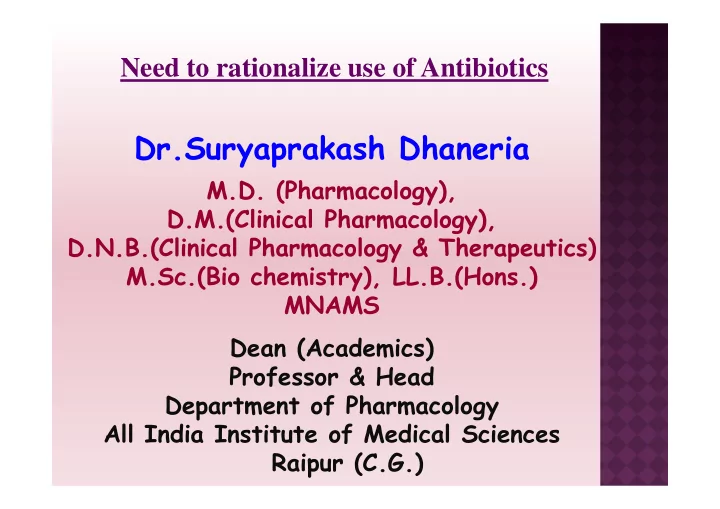

Need to rationalize use of Antibiotics Dr.Suryaprakash Dhaneria M.D. (Pharmacology), D.M.(Clinical Pharmacology), D.N.B.(Clinical Pharmacology & Therapeutics) M.Sc.(Bio chemistry), LL.B.(Hons.) MNAMS Dean (Academics) Professor & Head Department of Pharmacology All India Institute of Medical Sciences Raipur (C.G.)
•
Antibiotics are one of the most commonly prescribed drugs being responsible for 30-50 % of hospital’s total drug budget.
� In 2010 - 13 billion pills of Antibiotic were consumed in India as against 10 billion in China and 7 billion in USA annually. � In India Antibiotic use is increased by 43% from 2000 to 2010.
SELECTION OF ANTIBIOTICS On the basis of – 1. Clinical judgment. 2. Microbiological information. 3. Pharmacological knowledge.
Use of Antibiotics in every case of fever. Use of Antibacterial drug for the treatment of untreatable infections.
Use of Antibiotics where actually surgical intervention is required.
Unnecessary use of systemic Antibacterials.
Overreliance on parenteral antibiotics.
Inappropriate doses. Inadequate duration of therapy.
1. After clean elective surgery. 2. In neonates born after prolonged or instrumental delivery. 3. To prevent post partum infection after normal delivery. 4. To prevent secondary bacterial infection after viral infection. 5. To prevent respiratory infection in unconscious patient or those who are on ventilators.
Antibiotics used for prophylaxis are often inappropriately chosen and administered. 30% of antibiotics used in hospital are for prophylaxis and more than 80% are given inappropriately for >48h duration.
� Operations on abdomen. � Operation lasting for more than 2 hrs. � Contaminated or dirty wound classification. � At least 3 medical diagnosis.
� Clean contaminated wound � Contaminated wound � Dirty wound � Surgeries involving insertion of prosthetic material. � Heart surgery � Neurosurgery � Immunocompromised patient � Other risk factors
I - Clean � Elective � Primarily closed procedure. � Respiratory, GIT, biliary, genitourinary or oropharyngeal tract not entered. � No acute inflammation. � No break in aseptic O.T. technique. � Expected infection rate ≤ 2%.
II – Clean Contaminated • Urgent or emergency case that is otherwise clean. • Controlled opening of respiratory, GIT, biliary or oropharyngeal tract. • Minimum spillage or minor break in technique. • Expected infection rate ≤ 10 %.
III – Contaminated • Acute non-purulent inflammation. • Major technique break or major spill from hollow organs. • Penetrating trauma less than 4 hrs old. • Chronic open wound to be grafted or covered. • Expected infection rate about 20 %.
IV – Dirty • Purulent or abscess. • Pre-operative perforation of respiratory, GIT, biliary or oropharyngeal tract. • Penetrating trauma more than 4 hrs old. • Expected infection rate about 40 %.
� Most effective � Peak conc. > MIC � Least toxic � Least expensive � Not affecting normal flora of host
� Within 1 hr prior to incision � Intravenously
Cefazolin – 1 gm Intravenously (30 mg / kg .Bw)
AMPICILLIN – SULBACTAM 3 gm I/v (50 mg/Kg.Bw) Alternative to Cefazolin In – Lung surgery � Head neck cancer surgery � Plastic surgery � Biliary tract surgery �
Clindamycin – 600 mg I.V. + Gentamicin – 1.5 mg / Kg Bw I.V. Ciprofloxacin – 400 mg I.V. (10 mg / kg Bw)
Cefotetan – 2 gm I.V. ( 40 mg / kg Bw) Or Cefoxitin – 2 gm I.V. ( 40 mg / kg Bw) Or Cefazolin – 1 gm I.V. + Metronidazole – 500 mg I.V. (15 mg /kg Bw) Or Clindamycin – 600 mg I.V. (10 mg /kg Bw) ( In case of allergy to cephalosporin)
Vancomycin – 1 gm I.V. Or Teicoplanin – 200 mg I.V.
Mostly single dose Give additional dose of antibiotics in the event of intraoperative blood loss ( 1.5 L for adult or 25 ml/Kg Bw for children )
If antibiotic is to be continued post operatively, the duration should be less than 24 hrs regardless of the presence of intravascular catheters or indwelling drains.
24 hrs – Vascular Surgery Head & Neck Surgery Grade I/II open fractures Liver Transplant Penetrating Abdominal Trauma 48 hrs – Cardiothoracic Surgery Grade III open fractures Kidney Transplant 5 Days - Penetrating Trauma requiring Neurosurgery Lung Transplant
(If surgery is prolonged beyond 4 hrs) Drug Recommended Re-dosing Interval Cephalosporins, 4 h Clindamycin, – Ampicillin + Sulbactam Ciprofloxacin 6 h Metronidazole, 8 h Aminoglycosides 12 h Vancomycin
Delay in time to Surgical Incision >60 min Repeat pre-op-dose of antibiotic (except of Ciprofloxacin & Vancomycin) >120 min Repeat pre-op-dose of Ciprofloxacin >8 hrs Repeat pre-op-dose of Vancomycin
Newer drugs are always better drugs. Costly drugs are always better drugs. Polypharmacy is always better. FDCs are always better.
� Bad Bugs, No Drugs. � IDSA launched “10 X 20 initiative” .
Antibiotics have saved our lives for so long and now it is the time for us to save antibiotics.
� Medicines are nothing in themselves, but are the very hands of gods if employed with reason and prudence.” -Herophilus
Every prescription is the beginning of a new experiment Begin it carefully, remain vigilant make the patient healthy get blessed from the almighty
���� hank hank hank hank ou ou ou ou �Y �Y �Y �Y
Recommend
More recommend